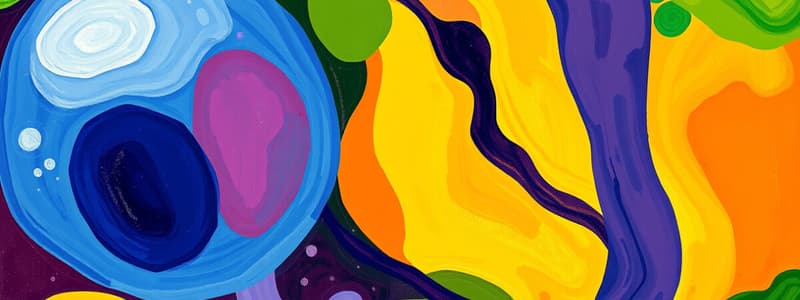Podcast
Questions and Answers
Which of the following substances can freely pass through the plasma membrane?
Which of the following substances can freely pass through the plasma membrane?
- Oxygen (correct)
- Glucose
- Ions
- Amino acids
Active transport allows molecules to move down their concentration gradient without using energy.
Active transport allows molecules to move down their concentration gradient without using energy.
False (B)
What is the function of aquaporin in the plasma membrane?
What is the function of aquaporin in the plasma membrane?
To facilitate the passage of water across the membrane.
_________ transport is the process that allows large particles to enter or exit the cell.
_________ transport is the process that allows large particles to enter or exit the cell.
Match the following terms with their descriptions:
Match the following terms with their descriptions:
What role do cholesterol molecules play in the plasma membrane at low temperatures?
What role do cholesterol molecules play in the plasma membrane at low temperatures?
Unsaturated fatty acids enhance membrane fluidity by creating kinks that hinder close packing of phospholipids.
Unsaturated fatty acids enhance membrane fluidity by creating kinks that hinder close packing of phospholipids.
What are the three types of membrane proteins?
What are the three types of membrane proteins?
Channel proteins allow the passage of _____ through the membrane.
Channel proteins allow the passage of _____ through the membrane.
Match each type of membrane protein with its function:
Match each type of membrane protein with its function:
Flashcards are hidden until you start studying
Study Notes
Plasma Membrane Fluidity
- Unsaturated fatty acids in membrane lipids increase fluidity in low temperatures by preventing close packing.
- Cholesterol molecules act as “fluidity buffers,” maintaining membrane stability across temperature variations; they prevent freezing at low temperatures and reduce excess fluidity at high temperatures.
Membrane Protein Types and Functions
- Integral Membrane Proteins: Amphipathic proteins firmly integrated into the membrane.
- Transmembrane Proteins: Extend completely across the membrane, serving various functions.
- Peripheral Membrane Proteins: Bound to either inner or outer membrane surfaces, associated with integral proteins.
Types of Membrane Proteins Based on Function
- Channel Proteins: Facilitate the passage of specific molecules through membrane channels.
- Carrier Proteins: Bind to molecules and assist their transport across the membrane.
- Cell Recognition Proteins: Glycoproteins/glycolipids serve as ID tags on the extracellular surface to identify foreign substances.
Plasma Membrane Permeability
- Selectively permeable, allowing some substances to pass while inhibiting others.
- Small, non-charged molecules (e.g., CO2, O2) can pass freely, while water moves through aquaporins, which help regulate osmotic pressure.
- Active transport is needed for moving molecules against their concentration gradient, requiring energy.
Types of Transport
- Passive Transport: Movement of molecules down their concentration gradient; types include simple diffusion and facilitated diffusion.
- Osmosis: The movement of water across a selectively permeable membrane, responding to solute concentrations.
- Isotonic Solutions: Equal solute and solvent concentrations; no net water movement.
- Hypotonic Solutions: Lower solute concentration outside; cells may swell or burst.
- Hypertonic Solutions: Higher solute concentration outside; cells may shrink.
Active Transport Mechanisms
- Sodium-Potassium Pump: Exchanges Na+ out of the cell and K+ into the cell using ATP, establishing polarization and creating an electrochemical gradient.
- Exocytosis: Vesicles fuse with the plasma membrane to release substances outside the cell (e.g., hormones, neurotransmitters).
- Endocytosis: Cells engulf substances, forming vesicles.
- Phagocytosis: Engulfing large particles (e.g., debris, pathogens).
- Pinocytosis: Engulfing liquids or small particles.
- Receptor-Mediated Endocytosis: Specific uptake via receptor binding.
Extracellular Matrix (ECM)
- Composed of proteins and polysaccharides produced by cells, providing structural and functional support.
- Components:
- Collagen: Provides tensile strength.
- Elastin: Imparts elasticity.
- Fibronectin: Connects cells to the ECM.
- Integrin: Facilitates cell signaling.
- Proteoglycans: Resist compression and regulate material passage.
Cell Junctions
- Adhesion Junctions: Connect adjacent cells with intercellular filaments (e.g., desmosomes).
- Gap Junctions: Allow direct communication between cells via plasma membrane channels.
- Tight Junctions: Create impermeable barriers to prevent leakage between cells (e.g., in kidney tubules).
Plant Cell Walls
- Composed mainly of cellulose, freely permeable to water and solutes, with plasmodesmata facilitating intercellular communication and transport.
Studying That Suits You
Use AI to generate personalized quizzes and flashcards to suit your learning preferences.




